2013 SUZUKI ERTIGA catalytic converter
[x] Cancel search: catalytic converterPage 89 of 207
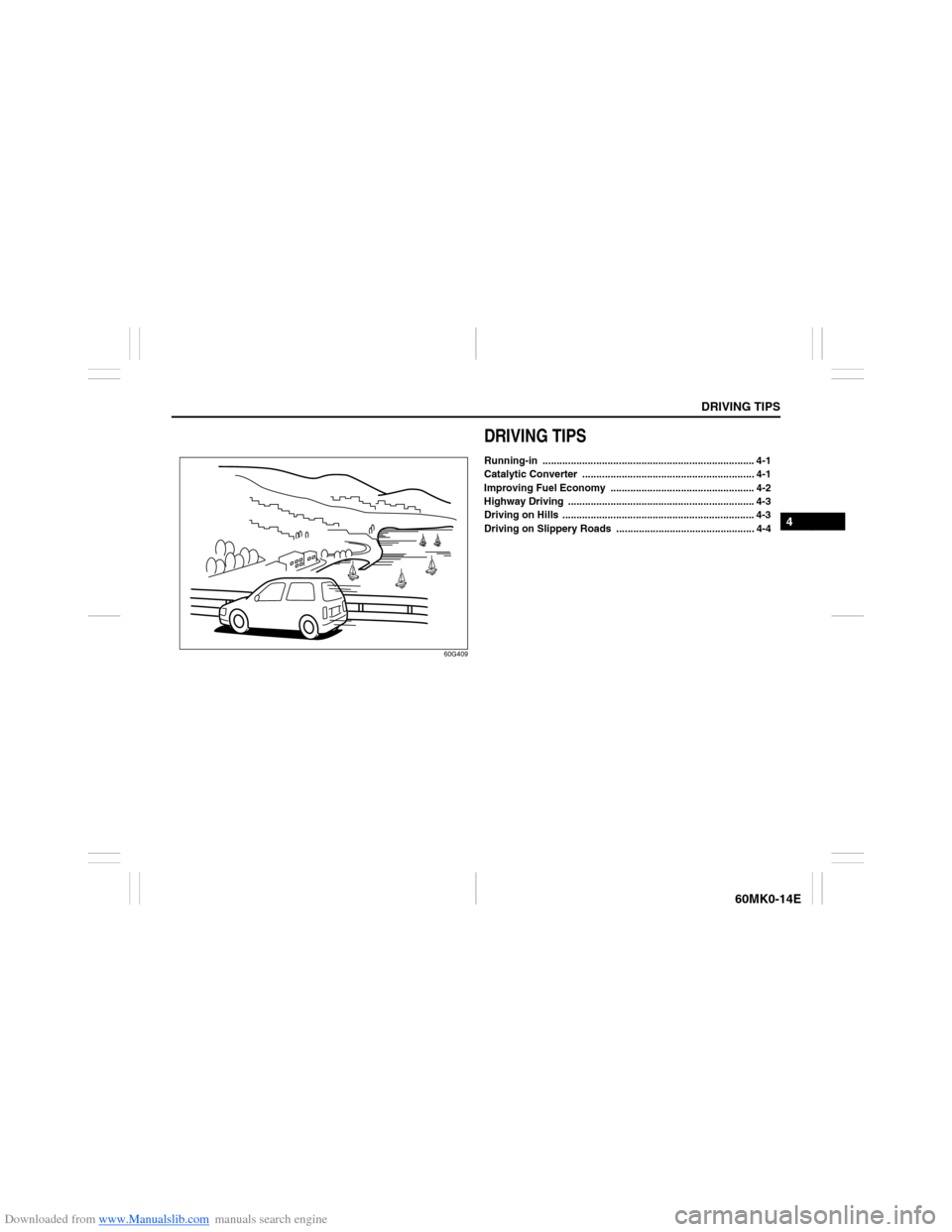
Downloaded from www.Manualslib.com manuals search engine DRIVING TIPS
4
60MK0-14E
60G409
DRIVING TIPSRunning-in ........................................................................... 4-1
Catalytic Converter ............................................................. 4-1
Improving Fuel Economy ................................................... 4-2
Highway Driving .................................................................. 4-3
Driving on Hills .................................................................... 4-3
Driving on Slippery Roads ................................................. 4-4
Page 90 of 207
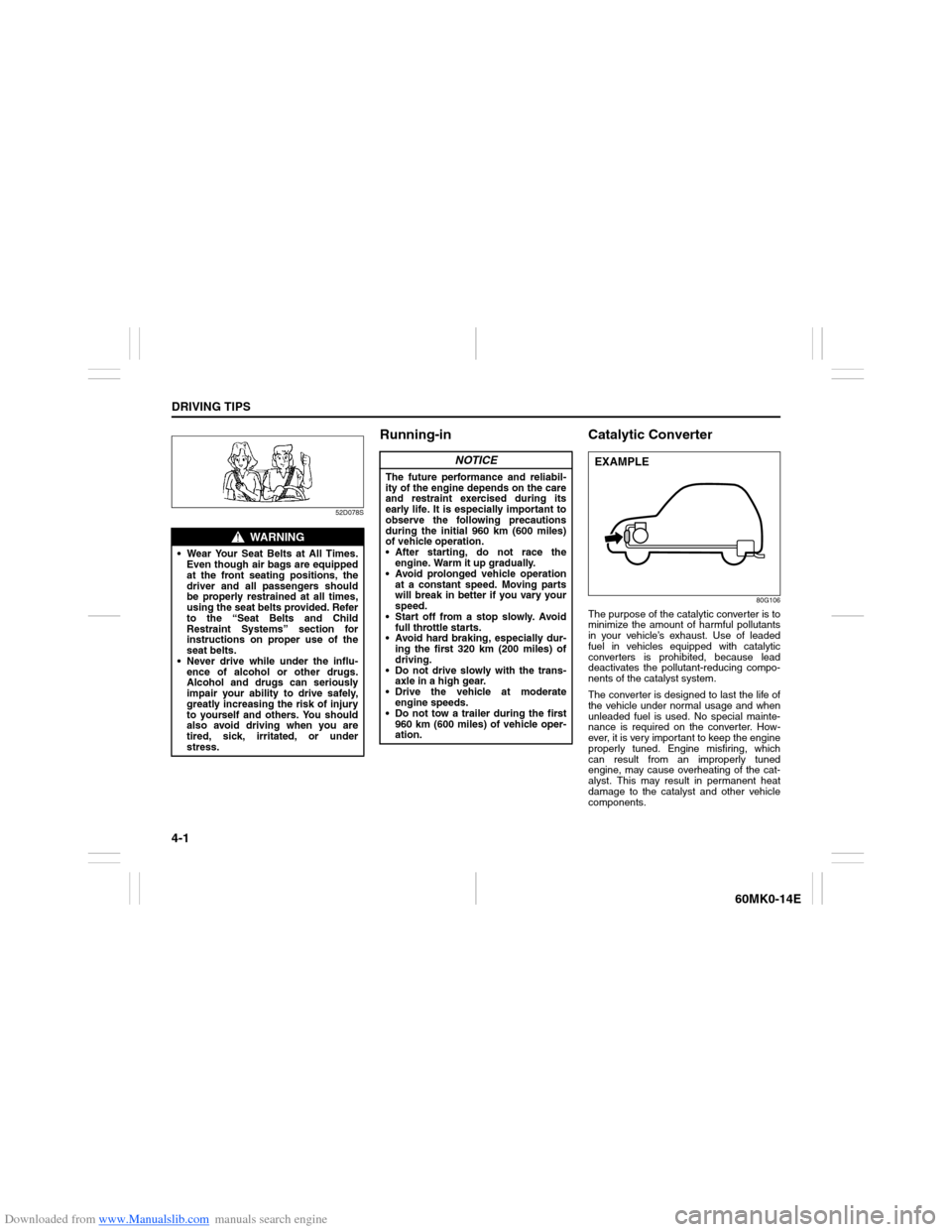
Downloaded from www.Manualslib.com manuals search engine 4-1DRIVING TIPS
60MK0-14E
52D078S
Running-in Catalytic Converter
80G106
The purpose of the catalytic converter is to
minimize the amount of harmful pollutants
in your vehicle’s exhaust. Use of leaded
fuel in vehicles equipped with catalytic
converters is prohibited, because lead
deactivates the pollutant-reducing compo-
nents of the catalyst system.
The converter is designed to last the life of
the vehicle under normal usage and when
unleaded fuel is used. No special mainte-
nance is required on the converter. How-
ever, it is very important to keep the engine
properly tuned. Engine misfiring, which
can result from an improperly tuned
engine, may cause overheating of the cat-
alyst. This may result in permanent heat
damage to the catalyst and other vehicle
components.
WARNING
Wear Your Seat Belts at All Times.
Even though air bags are equipped
at the front seating positions, the
driver and all passengers should
be properly restrained at all times,
using the seat belts provided. Refer
to the “Seat Belts and Child
Restraint Systems” section for
instructions on proper use of the
seat belts.
Never drive while under the influ-
ence of alcohol or other drugs.
Alcohol and drugs can seriously
impair your ability to drive safely,
greatly increasing the risk of injury
to yourself and others. You should
also avoid driving when you are
tired, sick, irritated, or under
stress.
NOTICE
The future performance and reliabil-
ity of the engine depends on the care
and restraint exercised during its
early life. It is especially important to
observe the following precautions
during the initial 960 km (600 miles)
of vehicle operation.
After starting, do not race the
engine. Warm it up gradually.
Avoid prolonged vehicle operation
at a constant speed. Moving parts
will break in better if you vary your
speed.
Start off from a stop slowly. Avoid
full throttle starts.
Avoid hard braking, especially dur-
ing the first 320 km (200 miles) of
driving.
Do not drive slowly with the trans-
axle in a high gear.
Drive the vehicle at moderate
engine speeds.
Do not tow a trailer during the first
960 km (600 miles) of vehicle oper-
ation.
EXAMPLE
Page 91 of 207
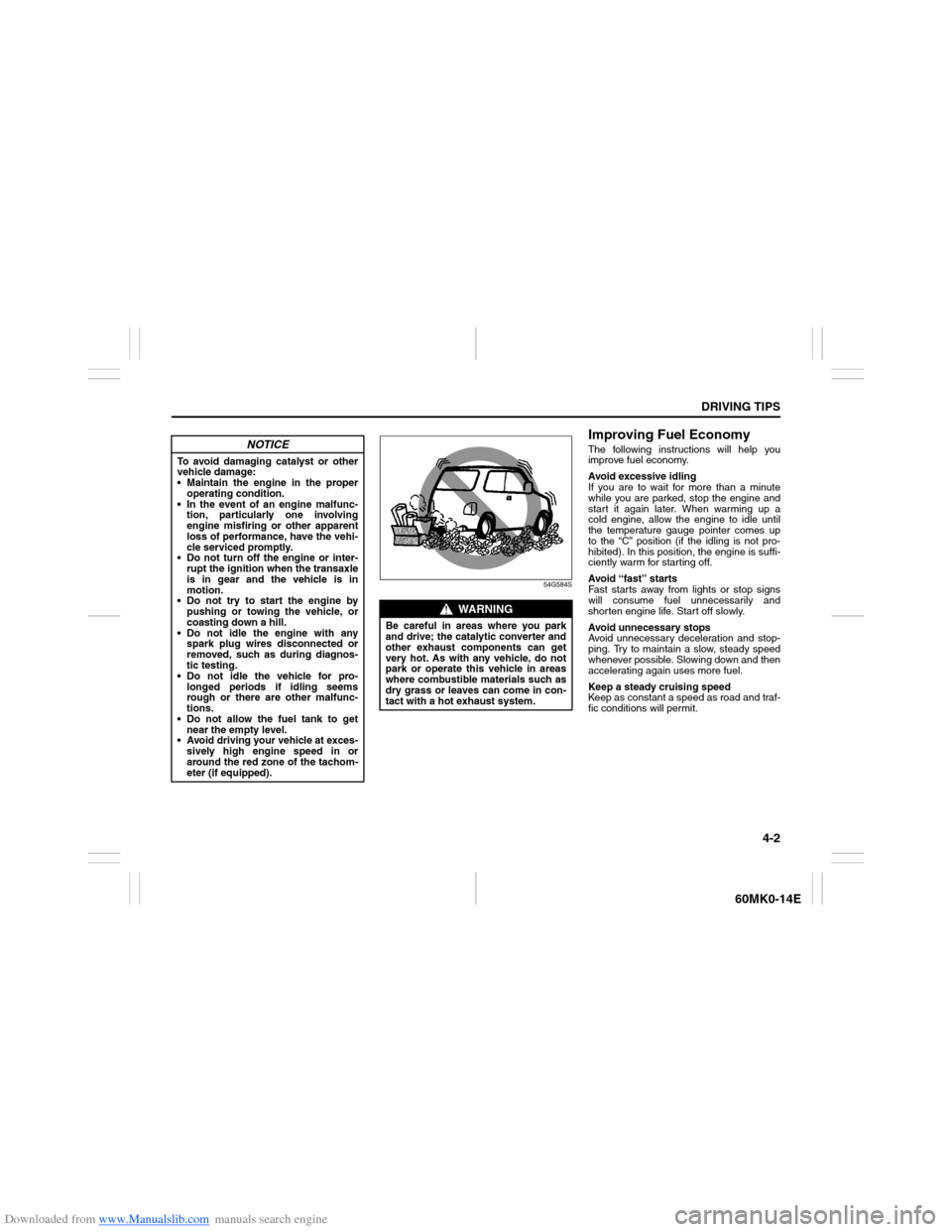
Downloaded from www.Manualslib.com manuals search engine 4-2
DRIVING TIPS
60MK0-14E
54G584S
Improving Fuel EconomyThe following instructions will help you
improve fuel economy.
Avoid excessive idling
If you are to wait for more than a minute
while you are parked, stop the engine and
start it again later. When warming up a
cold engine, allow the engine to idle until
the temperature gauge pointer comes up
to the “C” position (if the idling is not pro-
hibited). In this position, the engine is suffi-
ciently warm for starting off.
Avoid “fast” starts
Fast starts away from lights or stop signs
will consume fuel unnecessarily and
shorten engine life. Start off slowly.
Avoid unnecessary stops
Avoid unnecessary deceleration and stop-
ping. Try to maintain a slow, steady speed
whenever possible. Slowing down and then
accelerating again uses more fuel.
Keep a steady cruising speed
Keep as constant a speed as road and traf-
fic conditions will permit.
NOTICE
To avoid damaging catalyst or other
vehicle damage:
Maintain the engine in the proper
operating condition.
In the event of an engine malfunc-
tion, particularly one involving
engine misfiring or other apparent
loss of performance, have the vehi-
cle serviced promptly.
Do not turn off the engine or inter-
rupt the ignition when the transaxle
is in gear and the vehicle is in
motion.
Do not try to start the engine by
pushing or towing the vehicle, or
coasting down a hill.
Do not idle the engine with any
spark plug wires disconnected or
removed, such as during diagnos-
tic testing.
Do not idle the vehicle for pro-
longed periods if idling seems
rough or there are other malfunc-
tions.
Do not allow the fuel tank to get
near the empty level.
Avoid driving your vehicle at exces-
sively high engine speed in or
around the red zone of the tachom-
eter (if equipped).
WARNING
Be careful in areas where you park
and drive; the catalytic converter and
other exhaust components can get
very hot. As with any vehicle, do not
park or operate this vehicle in areas
where combustible materials such as
dry grass or leaves can come in con-
tact with a hot exhaust system.
Page 187 of 207
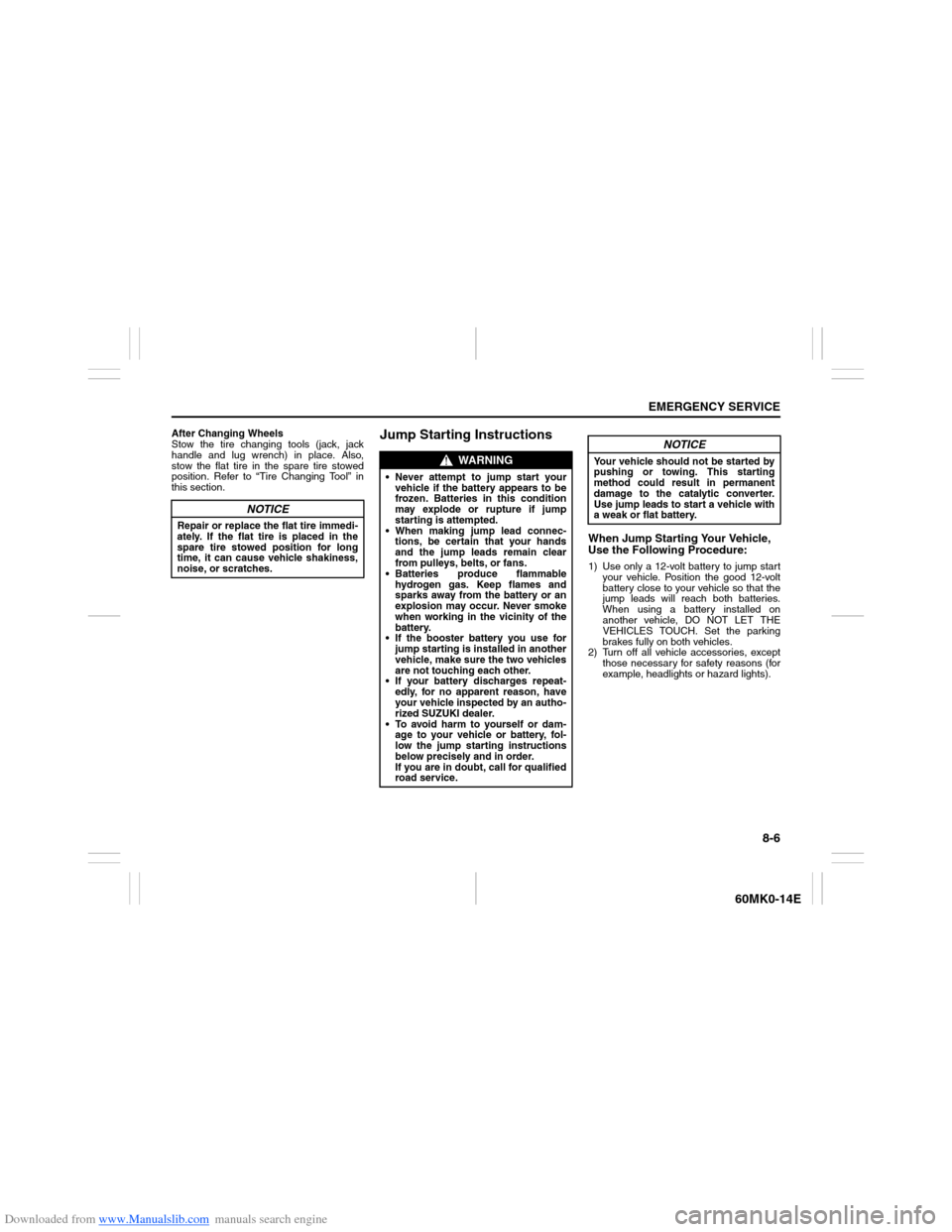
Downloaded from www.Manualslib.com manuals search engine 8-6
EMERGENCY SERVICE
60MK0-14E
After Changing Wheels
Stow the tire changing tools (jack, jack
handle and lug wrench) in place. Also,
stow the flat tire in the spare tire stowed
position. Refer to “Tire Changing Tool” in
this section.
Jump Starting Instructions
When Jump Starting Your Vehicle,
Use the Following Procedure:1) Use only a 12-volt battery to jump start
your vehicle. Position the good 12-volt
battery close to your vehicle so that the
jump leads will reach both batteries.
When using a battery installed on
another vehicle, DO NOT LET THE
VEHICLES TOUCH. Set the parking
brakes fully on both vehicles.
2) Turn off all vehicle accessories, except
those necessary for safety reasons (for
example, headlights or hazard lights).
NOTICE
Repair or replace the flat tire immedi-
ately. If the flat tire is placed in the
spare tire stowed position for long
time, it can cause vehicle shakiness,
noise, or scratches.
WARNING
Never attempt to jump start your
vehicle if the battery appears to be
frozen. Batteries in this condition
may explode or rupture if jump
starting is attempted.
When making jump lead connec-
tions, be certain that your hands
and the jump leads remain clear
from pulleys, belts, or fans.
Batteries produce flammable
hydrogen gas. Keep flames and
sparks away from the battery or an
explosion may occur. Never smoke
when working in the vicinity of the
battery.
If the booster battery you use for
jump starting is installed in another
vehicle, make sure the two vehicles
are not touching each other.
If your battery discharges repeat-
edly, for no apparent reason, have
your vehicle inspected by an autho-
rized SUZUKI dealer.
To avoid harm to yourself or dam-
age to your vehicle or battery, fol-
low the jump starting instructions
below precisely and in order.
If you are in doubt, call for qualified
road service.
NOTICE
Your vehicle should not be started by
pushing or towing. This starting
method could result in permanent
damage to the catalytic converter.
Use jump leads to start a vehicle with
a weak or flat battery.
Page 193 of 207
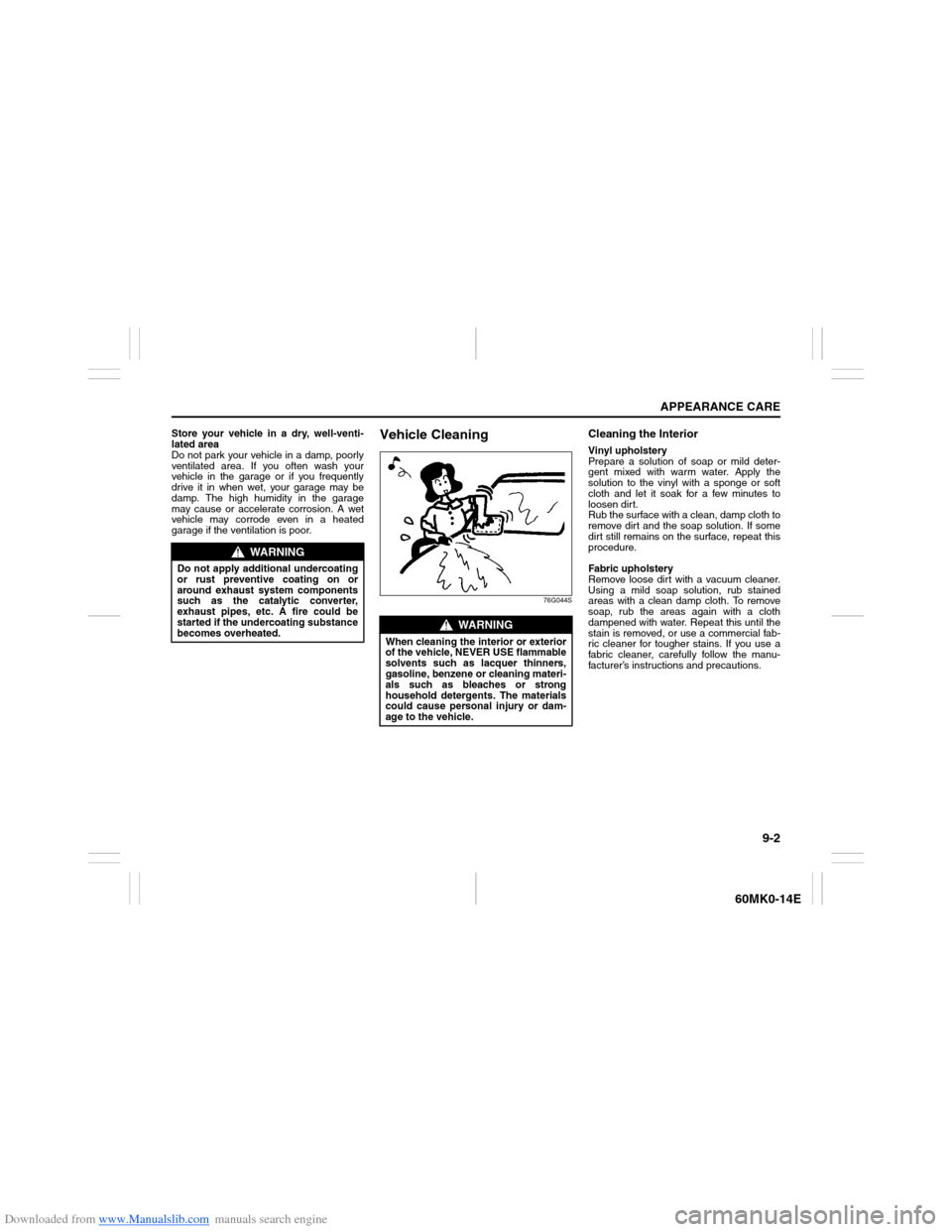
Downloaded from www.Manualslib.com manuals search engine 9-2
APPEARANCE CARE
60MK0-14E
Store your vehicle in a dry, well-venti-
lated area
Do not park your vehicle in a damp, poorly
ventilated area. If you often wash your
vehicle in the garage or if you frequently
drive it in when wet, your garage may be
damp. The high humidity in the garage
may cause or accelerate corrosion. A wet
vehicle may corrode even in a heated
garage if the ventilation is poor.
Vehicle Cleaning
76G044S
Cleaning the InteriorVinyl upholstery
Prepare a solution of soap or mild deter-
gent mixed with warm water. Apply the
solution to the vinyl with a sponge or soft
cloth and let it soak for a few minutes to
loosen dirt.
Rub the surface with a clean, damp cloth to
remove dirt and the soap solution. If some
dirt still remains on the surface, repeat this
procedure.
Fabric upholstery
Remove loose dirt with a vacuum cleaner.
Using a mild soap solution, rub stained
areas with a clean damp cloth. To remove
soap, rub the areas again with a cloth
dampened with water. Repeat this until the
stain is removed, or use a commercial fab-
ric cleaner for tougher stains. If you use a
fabric cleaner, carefully follow the manu-
facturer’s instructions and precautions.
WARNING
Do not apply additional undercoating
or rust preventive coating on or
around exhaust system components
such as the catalytic converter,
exhaust pipes, etc. A fire could be
started if the undercoating substance
becomes overheated.
WARNING
When cleaning the interior or exterior
of the vehicle, NEVER USE flammable
solvents such as lacquer thinners,
gasoline, benzene or cleaning materi-
als such as bleaches or strong
household detergents. The materials
could cause personal injury or dam-
age to the vehicle.
Page 203 of 207

Downloaded from www.Manualslib.com manuals search engine 12-1
INDEX
12
60MK0-14E
INDEXSymbols“AIR BAG” Light .................................................................. 2-40Numerics4-Speed Automatic Transaxle ............................................ 3-10AAccelerator Pedal .................................................................. 3-7
Accessory Socket ................................................................ 5-41
Adding Coolant .................................................................... 7-12
Adjusting Seat Position ...................................................... 2-14
Adjusting Seat Position (for 2nd row seats) ..................... 2-16
Adjusting Seatbacks .................................................. 2-15, 2-16
Air Cleaner............................................................................ 7-13
Air Conditioning System .............................................. 5-1, 7-35
All Seat Belts Except Center of 2nd Row Seat.................. 2-23
Anti-Lock Brake System (ABS) .......................................... 3-13
Anti-Lock Brake System (ABS) Warning Light ................. 2-39
Anti-Theft Feature ................................................................ 5-31
Armrest ................................................................................. 5-44
Assist Grips.......................................................................... 5-42
Audio System ......................................................................... 5-7
Automatic Transaxle ........................................................... 3-10
Automatic Transaxle (AT) Fluid.......................................... 7-16
Average fuel consumption......................................... 2-47, 2-49BBattery .................................................................................. 7-22
Bottle holder......................................................................... 5-43
Brake Assist System ........................................................... 3-13
Brake Fluid ........................................................................... 7-17
Brake Pedal ................................................................... 3-7, 7-18Brake System Warning Light .............................................. 2-38
Brakes ................................................................................... 7-17
Braking .................................................................................. 3-12
Brightness Control............................................................... 2-45
Bulb Replacement ................................................................ 7-26
CCatalytic Converter ................................................................ 4-1
CD Player .............................................................................. 5-15
Center Seat Belt of 2nd Row Seat ...................................... 2-24
Central Door Locking System ............................................... 2-3
Changing Engine Oil and Filter............................................. 7-9
Changing Wheels ................................................................... 8-5
Charging Light...................................................................... 2-40
Chassis Serial Number ........................................................ 10-1
Child Restraint Systems ...................................................... 2-27
Child-Proof Locks (rear door) ............................................... 2-3
Clock ..................................................................................... 2-50
Clutch Pedal .................................................................. 3-7, 7-16
Coolant Level Check ............................................................ 7-12
Coolant Replacement .......................................................... 7-12
Corrosion Prevention ............................................................ 9-1
Cup Holder and Storage Area ............................................. 5-43DDaily Inspection Checklist..................................................... 3-1
Door Locks ............................................................................. 2-2
Downshifting maximum allowable speeds .......................... 3-9
Drive Belt ................................................................................ 7-7
Driver’s Seat Belt Reminder ................................................ 2-25
Driver’s Seat Belt Reminder Light ...................................... 2-40
Driving on Hills ....................................................................... 4-3
Driving on Slippery Roads .................................................... 4-4